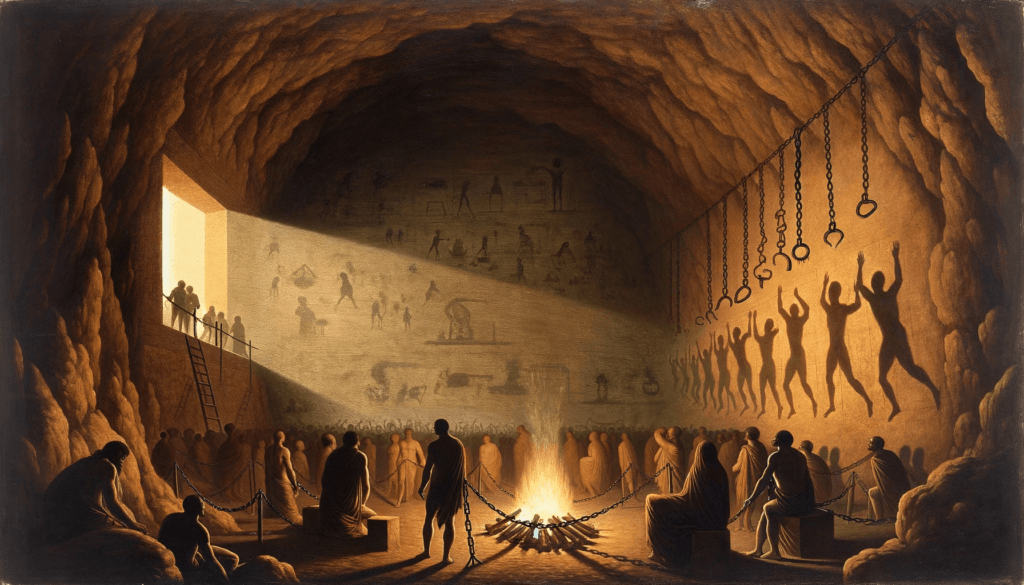Allegory Of The Cave: Journey from Shadows to the Truth
The Allegory of the Cave is also known as Plato’s Allegory of the Cave and it is one of the most influential philosophical metaphors in the Western School of Thought. Plato’s work, The Republic, has the cave metaphor that personifies the spiritual journey from illusion to truth.
How does the cave metaphor parallel allegory in religion?
Plato’s allegory of the cave resonates deeply with spiritual seekers aiming to break through false narratives and rediscover their divine essence.
- False narratives are a symbol of wrong beliefs and chains that bind us in illusion.
- Religious texts encourage us to move from ignorance to awareness, echoing the ethos of Plato’s Allegory.
- The concept of seeing shadows on the cave wall is deeply tied to the illusion of Maya in Eastern traditions.
While there may not be an exact equivalent of the allegory of the cave in all religions, there are similar concepts or teachings in various religious and spiritual traditions that convey similar ideas of illusion, ignorance, and enlightenment.
Maya In Hinduism and Buddhism
In Hinduism and Buddhism, the concept of Maya refers to the illusory nature of the material world and the ignorance that keeps individuals from realizing their true nature. The goal of spiritual practice in Hinduism is to transcend Maya and attain self-realization or enlightenment. Many other religions, from the Abrahamic religions to Zoroastrianism and more, employ various metaphors to emphasize the need for the light of truth to triumph over the darkness of ignorance.

Cave Metaphor Across Different Religions
- Ancient Greece
“Behold! Human beings living in an underground den, which has a mouth open towards the light and reaching all along the den; here they have been from their childhood, and have their legs and necks chained so that they cannot move, and can only see before them, being prevented by the chains from turning round their heads. Above and behind them a fire is blazing at a distance, and between the fire and the prisoners there is a raised way; and you will see, if you look, a low wall built along the way, like the screen which marionette players have in front of them, over which they show the puppets.”
– Plato, Ancient Greek philosopher
- Buddhism
“[Bodhidharma] faced the wall of his cave in zazen [meditation] for the last nine years of his life, though he had long ago found that wall, that barrier to be altogether transparent.”
—Robert Aitken, Zen Buddhist teacher and translator
- Hinduism
“Few see through the veil of Maya […] Delusion arises from the duality of attraction and aversion, Arjuna; every creature is deluded by these from birth. But those who have freed themselves from all wrongdoing are firmly established in worship of me.”
—The Bhagavad Gita, a Hindu text
- Christianity
“The people living in darkness have seen a great light; on those living in the land of the shadow of death, a light has dawned.”
— The New Testament (Matthew 4:16), Christian scripture
- Islam
Since you have distanced yourselves from them and what they worship besides Allah, take refuge in the cave. Your Lord will extend His mercy to you and accommodate you in your ordeal.”
–The Qur’an (18:16), Islamic scripture
- Sikhism
“Within the cave of the heart, the Divine Light is shining. Focus your meditation upon the Divine Light and all your doubts shall be dispelled.”
— Guru Nanak, founding Sikh prophet
Related reads
Charioteer | Sacred words | Religious wear | Cosmic Tree | Beyond Happiness | Tree of life | Sacred music | Fire as a symbol |
For more reflections on personal growth, wisdom and happiness, browse through our website.


